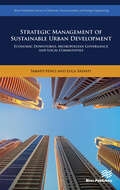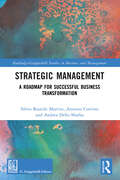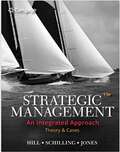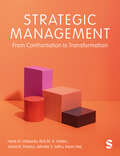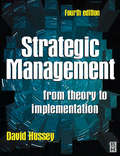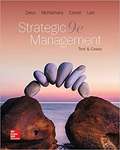- Table View
- List View
Strategic Management of Innovation and Design
by Pascal Le Masson Benoît Weil Armand Hatchuel Pascal Le Masson Benoît WeilThere is now widespread agreement that innovation holds the key to future economic and social prosperity in developed countries. Experts studying contemporary capitalism also agree that the battle against unemployment and relocations can only be won through innovation. But what kind of innovation is required and what is the best way to manage, steer and organize it? Grounded on experiences of innovative firms and based on the most recent design theories, this book argues that instead of relying on traditional R&D and project management techniques, the strategic management of innovation must be based on innovative design activities. It analyses and explains new management principles and techniques that deal with these activities, including innovation fields, lineages, C-K (Concept-Knowledge) diagrams and design spaces. The book is ideal for advanced courses in innovation management in industrial design schools, business schools, engineering schools, as well as managers looking to improve their practice.
Strategic Management of Professional Service Firms: Theory and Practice
by Max Josef Ringlstetter Stephan KaiserManaging strategies for professional service firms is an important and complex activity. The main issues in this book cover the core management principles for service firms in a comprehensive way. Based on current research findings it includes the management of service quality, knowledge and marketing as well as people, organizational and strategic issues. In understanding critical resources managers and partners will be able to effectively develop and exploit them. The book contains practical advice and offers a profound insight into the managerial excellence of service companies.
Strategic Management of Research Organizations
by William BarlettaThis entry-level text describes a tested top-down enterprise-wide approach to managing organizations with a predominant portion of their product being scientific or technological research. It focuses on executive performance and strategic forecasting and planning; goal-setting; communications and marketing, and operations management to realize strategic objectives. This book will be of interest to entrepreneurs, established scientists and engineers and to those studying toward an MBA with specialization in research institutions and major research infrastructures, preparing them to move from research or academia into their first managerial position. It also provides valuable advice and guidance for established middle and senior management in established research enterprises. Features: Provides an accessible and easy to follow introduction to strategic management methodologies Explores best practices for communication, marketing, and risk management Discusses workforce management as related to realizing strategic goals and plans
Strategic Management of Sustainable Urban Development: Economic Downturns, Metropolitan Governance and Local Communities
by Luca Salvati Sabato VinciIf we assume recession as being the starting point for policy challenges, then we can interpret these economic downturns as opportunities for change and the reshaping of society, landscapes and the latent mechanisms of growth. This book illustrates different aspects of local strategic development introducing a novel interpretation of the intimate relationship between demographic and economic aspects in complex socio-environmental systems. A specific approach investigating the mechanisms of local development, cultural and environmental values within a strategic territorial vision, is proposed. Coming from and appealing to diverse academic backgrounds, our book address paradigmatic visions about regional and urban dynamics, focusing on landscape transformations and socioeconomic disparities. Technical topics discussed in the book include:Urban management; Metropolitan governance; ? Landscape; Spatial planning; Applied economics;Regional demography.
Strategic Management of Technological Learning (Technology Management Series)
by Elias CarayannisHow do companies such as BMW, Airbus Industrie, and Bayer leverage technology and learn to thrive where others fail? This book provides a one-stop resource on technology, innovation, and knowledge management. It gives you a tool for gaining short-term, case-specific insight and long-term, industry-wide understanding of the best technology management and learning policies and practices. The Strategic Management of Technological Learning explores a portfolio of case studies on technology-driven-but not exclusively high-tech-companies that have an overall long-term record of success and prosperity.Through in-depth interviews with industry practitioners, the author empirically identifies the presence of Strategic or Active Incrementalism. The following chart shows the studied firms, which operate at high risk and uncertainty, very dynamic, and technologically intensive business environments:
Strategic Management, Decision Theory, and Decision Science: Contributions to Policy Issues
by Bikas Kumar Sinha Srijib Bhusan BagchiThis book contains international perspectives that unifies the themes of strategic management, decision theory, and data science. It contains thought-provoking presentations of case studies backed by adequate analysis adding significance to the discussions. Most of the decision-making models in use do take due advantage of collection and processing of relevant data using appropriate analytics oriented to provide inputs into effective decision-making. The book showcases applications in diverse fields including banking and insurance, portfolio management, inventory analysis, performance assessment of comparable economic agents, managing utilities in a health-care facility, reducing traffic snarls on highways, monitoring achievement of some of the sustainable development goals in a country or state, and similar other areas that showcase policy implications. It holds immense value for researchers as well as professionals responsible for organizational decisions.
Strategic Management: A Competitive Advantage Approach, Concepts and Cases
by Forest R. David Fred R David Meredith E. DavidStrategic Management: A Competitive Advantage Approach, Concepts and Cases shows how to gain and sustain a competitive advantage in today's complex business world. The text helps you develop your own cutting-edge strategy through skill-developing exercises. It also offers coverage on issues related to business ethics, social responsibility, global operations, and sustainability. The 17th Edition features updated research, cases and examples. As a result, you'll be able to effectively formulate and implement a plan that can lead to a sustainable competitive advantage for any type of business.
Strategic Management: A Critical Introduction
by Richard GodfreyRegularly considered to be the cap-stone course on any business or management degree, strategy has developed into a wide-ranging and sometimes overwhelming field of study. However, in recent years the theory of strategy has come under increasing scrutiny for its perceived failures and detachment from real world practice. With an engaging and conversational tone, this new concise textbook offers an accessible and timely review of the theory and practice of strategic management, explored from a more critical perspective. In a refreshing change from much of the literature, Richard Godfrey takes a wider view of strategy, incorporating insights from the worlds of sociology, psychology and history to highlight the complexity and plurality at the heart of the discipline. The book also incorporates a number of extensive case studies on contemporary business strategy from the likes of Apple, Nike, Zara and IKEA. Written for both an undergraduate and postgraduate audience, the book challenges a number of underlying assumption and beliefs about strategy and seeks to add clarity and context to the field.
Strategic Management: A Roadmap for Successful Business Transformation (Routledge-Giappichelli Studies in Business and Management)
by Silvio Bianchi Martini Antonio Corvino Andrea Dello SbarbaThis book explores the intricate world of strategic management. Blending theory with practical examples, the authors provide a systematic framework for strategic decisionmaking. The book is divided into two parts. It begins by exploring the perspectives of strategic analysis, examining the firm’s “current situation” and “evolutionary” perspectives, as well as the “objective reality” and “subjective perspective”. These interconnected perspectives require different analytical approaches to understand the firm’s present state and the process of change. The second part, entitled “The strategic map: the areas, the pathway and the objects of analysis”, delves deeper into specific areas of strategic analysis. It focuses on the current state of the firm (today’s firm), emphasizing the importance of understanding its resources, products, markets, activities, and stakeholder relationships. The quality and implementation effectiveness of the strategic model are also assessed, providing a reflection tool for improvement. The book further explores strategic change processes, the values and identity of the firm, performance evaluation, and corporate governance and internal control system. Suitable for newcomers and professionals in corporate strategy and governance, this book combines theory and practical examples to enhance understanding.
Strategic Management: An Integrated Approach
by Gareth R. Jones Charles W. L. Hill Melissa A. SchillingThis comprehensive and engaging text presents the complexities of strategic management through up-to-date scholarship and hands-on applications. Highly respected authors Hill, Schilling, and Jones integrate cutting-edge research on topics including competitive advantage, corporate governance, diversification, strategic leadership, technology and innovation, and corporate social responsibility through both theory and case studies. <p><p> Based on real-world practices and current thinking in the field, the 12th edition features an increased emphasis on the changing global economy and its role in strategic management. When paired with this student-centric text, the MindTap learning solution will prepare the next generation of strategic leaders.
Strategic Management: An Integrated Approach
by Gareth R. Jones Charles W. L. Hill Melissa A. SchillingMindTap for Hill/Schilling/Jones' Strategic Management: Theory & Cases, 13th helps you learn on your terms. INSTANT ACCESS IN YOUR POCKET. Take advantage of the MindTap Mobile App to learn on your terms. Read or listen to textbooks and study with the aid of instructor notifications, flashcards and practice quizzes. MINDTAP HELPS YOU CREATE YOUR OWN POTENTIAL. GEAR UP FOR ULTIMATE SUCCESS. Track your scores and stay motivated toward your goals. Whether you have more work to do or are ahead of the curve, you'll know where you need to focus your efforts. And the MindTap Green Dot will charge your confidence along the way. MINDTAP HELPS YOU OWN YOUR PROGRESS. MAKE YOUR TEXTBOOK YOURS. No one knows what works for you better than you. Highlight key text, add notes and create custom flashcards. When it's time to study, everything you've flagged or noted can be gathered into a guide you can organize.
Strategic Management: Competitiveness and Globalization (Tenth Edition)
by Michael A. Hitt R. Duane Ireland Robert E. HoskissonIntroduce strategic management using the market-leading text that sets the standard for the most complete, relevant presentation. Written by highly respected experts and prestigious scholars, Hitt/Ireland/Hoskisson's STRATEGIC MANAGEMENT: COMPETITIVENESS AND GLOBALIZATION, CONCEPTS AND CASES, 10E provides an intellectually rich, yet thoroughly practical analysis of strategic management today. This unique text is the only one to integrate the classic industrial organization model with a resource-based view of the firm to give readers a complete understanding of how today's businesses use strategic management to establish a sustained competitive advantage. The authors present cutting-edge research and strategic management trends within a strong global focus, using memorable examples from more than 600 companies. A wealth of learning features and selection of 30 all-new compelling cases prepare your students to face the broad range of critical issues confronting contemporary managers. Engaging video cases, CengageNOW online teaching tools, and a complete electronic business library keeps study current and relevant.
Strategic Management: Concepts
by Robert Jensen Jeffrey H. Dyer Paul Godfrey David Bryce W. Gibb DyerDesigned for the Strategic Management course, Strategic Management: Concepts and Tools for Creating Real World Strategy by Jeff Dyer, Paul Godfrey, Robert Jensen, and David Bryce will make your life easier. This text delivers an insightful and concise introduction to the concepts of strategy with a strong mix of professional applications drawing on the authors' personal experiences. Acting as consultants for your classroom, the authors developed this product in a manner that helps to spark ideas, fuel creative thinking and discussion, and introduce innovative learning technologies that aids students.
Strategic Management: Concepts and Cases: Competitiveness and Globalization
by Michael A. Hitt R. Duane Ireland Robert E. HoskissonExamine strategic management with the market-leading book that sets the standard as today's most intellectually rich, practical analysis of strategic management. Written by prominent management scholars and award-winning instructors. 13E incorporates cutting-edge research and new examples from more than 600 companies to reveal how firms effectively use the strategic management process. This edition combines a classic industrial organization model with a resource-based view of the firm to demonstrate how businesses establish competitive advantages and create value for stakeholders in the global marketplace. You study how firms govern themselves, the value of strategic alliances to global companies and the value firms create by melding strategic management and entrepreneurial behaviors when competing. Also included at no additional charge are 20 leading business cases, carefully selected by the authors, which cover several US and international businesses across many industries. With STRATEGIC MANAGEMENT you gain the insights and understanding you need to outperform competitors and excel as a strategic leader.
Strategic Management: Formulation, Implementation, and Control in a Dynamic Environment
by Abbass Alkhafaji Richard Alan NelsonAirborne Express, Hershey's, Motorola, Pillsbury-how do the executives of international corporations formulate effective strategies for corporate success? Filled with helpful insights into the state of the art in strategic management, this book provides a framework for the formulation, implementation, and control of strategies for all types of domestic and global organizations. You'll also find 21 suggested corporate cases for analysis (complete with reference sources), including Blockbuster Video, PepsiCo, Harley-Davidson, Nike, Home Depot, and Microsoft. This up-to-date volume gives you a comprehensive overview of strategic management in an easy-to-read format. It addresses important current issues, such as TQM (Total Quality Management), reengineering, benchmarking, and the formulation of strategic management in international markets. Strategic Management: Formulation, Implementation, and Control in a Dynamic Environment is a part of The Haworth Press, Inc. promotion book series edited by Richard Alan Nelson, Ph.D., APR. Here is a small sample of what Strategic Management: Formulation, Implementation, and Control in a Dynamic Environment will teach you about: the definition, meaning, and history of strategic management the difference between business policy and business strategy corporate structure, governance, and culture mission statements how to assess the corporate/business environment-internal, external, and macro how to formulate an effective business strategy strategic alternatives-specialization, diversification, alliances, joint ventures, acquisitions, and more dealing with foreign governments and competing on a global scale the role of the general manager and the board of directors the control process and ways to measure the financial soundness of strategic decisions management techniques for not-for-profit companies Strategic Management: Formulation, Implementation, and Control in a Dynamic Environment is an ideal reference for any teacher, student, or professional in the management arena.
Strategic Management: From Confrontation to Transformation
by Kevin Heij Henk W. Volberda Rick M. Hollen Joana R. Pereira Jatinder S. SidhuIn the quest for competitive advantage, navigating change can be daunting. Following a unique, four-part structure focussing on confronting strategic issues, sensing opportunities and threats, choosing strategies and transforming organizations, this essential textbook offers a fresh and provocative perspective on strategic management. Covering the latest theories and concepts and taking an action-oriented approach, the book includes: • Cutting-edge content on the confront-sense-choose-transform stages of strategic management such as purpose and sustainability, emerging technologies, ecosystems and platforms, and business model innovation • Four diagnostic chapters providing practical tools for each stage of the strategy process • Nearly 70 case studies of internationally recognisable companies like Airbnb, Ben & Jerry’s, Epic Games store, Hilton, Icebreaker, McDonald’s, Nestlé, Northvolt, Tesla and PayPay • ‘Key Debate’ boxes outlining opposing perspectives on hot topics in the strategy field and ‘Strategic Focus’ boxes digging deeper into contemporary phenomena Instructors can access a range of online resources, including a teaching guide complete with case study teaching notes, further reading and video links, PowerPoints and a bank of additional case studies. Suitable for undergraduate and postgraduate students of strategy, Strategic Management: From Confrontation to Transformation will help you grow your knowledge and experience of developing and implementing strategy in the real world. Henk W. Volberda is Professor of Strategy & Innovation at the Amsterdam Business School, University of Amsterdam. Rick M.A. Hollen is a Lecturer and Researcher at the Strategy & International Business section of the Amsterdam Business School, University of Amsterdam and a Managing Research Associate at the Amsterdam Centre for Business Innovation (ACBI). Joana R. Pereira is Lecturer in the Strategy and Organization group of Leeds University Business School, University of Leeds. Jatinder S. Sidhu is Professor and Chair in Strategic Management and Organization at Leeds University Business School, University of Leeds. Kevin Heij is Senior Researcher of the Amsterdam Centre for Business Innovation at the Amsterdam Business School, University of Amsterdam.
Strategic Management: From Confrontation to Transformation
by Kevin Heij Henk W. Volberda Rick M. Hollen Joana R. Pereira Jatinder S. SidhuIn the quest for competitive advantage, navigating change can be daunting. Following a unique, four-part structure focussing on confronting strategic issues, sensing opportunities and threats, choosing strategies and transforming organizations, this essential textbook offers a fresh and provocative perspective on strategic management. Covering the latest theories and concepts and taking an action-oriented approach, the book includes: • Cutting-edge content on the confront-sense-choose-transform stages of strategic management such as purpose and sustainability, emerging technologies, ecosystems and platforms, and business model innovation • Four diagnostic chapters providing practical tools for each stage of the strategy process • Nearly 70 case studies of internationally recognisable companies like Airbnb, Ben & Jerry’s, Epic Games store, Hilton, Icebreaker, McDonald’s, Nestlé, Northvolt, Tesla and PayPay • ‘Key Debate’ boxes outlining opposing perspectives on hot topics in the strategy field and ‘Strategic Focus’ boxes digging deeper into contemporary phenomena Instructors can access a range of online resources, including a teaching guide complete with case study teaching notes, further reading and video links, PowerPoints and a bank of additional case studies. Suitable for undergraduate and postgraduate students of strategy, Strategic Management: From Confrontation to Transformation will help you grow your knowledge and experience of developing and implementing strategy in the real world. Henk W. Volberda is Professor of Strategy & Innovation at the Amsterdam Business School, University of Amsterdam. Rick M.A. Hollen is a Lecturer and Researcher at the Strategy & International Business section of the Amsterdam Business School, University of Amsterdam and a Managing Research Associate at the Amsterdam Centre for Business Innovation (ACBI). Joana R. Pereira is Lecturer in the Strategy and Organization group of Leeds University Business School, University of Leeds. Jatinder S. Sidhu is Professor and Chair in Strategic Management and Organization at Leeds University Business School, University of Leeds. Kevin Heij is Senior Researcher of the Amsterdam Centre for Business Innovation at the Amsterdam Business School, University of Amsterdam.
Strategic Management: From Theory to Implementation
by David E. HusseyA major textbook on strategic management which not only deals fully with the theoretical aspects of corporate planning, but also provides practical guidance on implementation. Now completely revised and updated this book is particularly suitable for the student or manager who needs to relate strategic thinking to current practice. The format has been enlarged and the interior of the book re-designed. The fourth edition treats both analytical and behavioural aspects of planning in depth. Strategic analysis is covered in particular detail, with examples reporting proven - and often original - applications of these theories. Six major case studies have been added to illustrate the application of strategic management theory in practice and a chapter discusses the impact of new approaches to strategy. With comprehensive reference lists, and a guide to research resources, this volume will prove invaluable to researchers and advanced students as well as to the practising manager. A lecturer's resource is available on the BH website which contains a Powerpoint presentation, additional case studies and notes and exercises for seminar use. Details are available by emailing bhmarketing@repp.co.uk'a highly commendable piece of work, a true compendium for the practitioner and student of planning.' - Journal of Strategic Change (review of the third edition)
Strategic Management: From Theory to Practice
by Andrew Ward Allen C. AmasonA focus on creating and sustaining a flow of profitable transactions, in other words, the creation of sustainable competitive advantage is the seemingly simple, yet complex goal of strategic leaders and managers. Allen Amason and Andrew Ward approach the topic of strategic management with this focus in mind. Rather than simply teaching theory and research, Amason and Ward seek to convey the fundamental keys to how strategy works. This book is designed to help students think critically and understand fully how to strategically manage their future firms. In so doing, it will enable them to adapt and learn, even as their circumstances change; to apply sound logic and reasoning, even in new and unfamiliar settings. By conveying enduring and fundamental principles of economic and human behavior rather than simply reporting on the latest innovations, this book succeeds in preparing students to excel in the business environment over time, regardless of how it evolves.
Strategic Management: Fundamental Concepts for Decision Making and Strategy Execution (Classroom Companion: Business)
by Arão SapiroThis book provides students with the fundamental concepts and stages of strategic management and planning in organizations with essential tools to make decisions in order to remain competitive in the business world of today. It offers an introduction to the key topics and themes of organizational and competitive strategies and provides a panoramic view of the changing corporate environment. The author draws on insights from various typical functional courses, such as marketing, finance, and accounting, to help students understand how top executives and managers make the strategic decisions that drive successful businesses. Students learn how to conduct a case analysis, measure organizational performance, and conduct external and internal analyses. The book features learning objectives, glossaries, and real cases related to the content of each chapter. The book also features discussions on the execution and evaluation of organizational performance; environment,social, and governance (ESG); and decision and risk analysis. This book is useful for upper undergraduate and graduate level courses in strategic planning and management, business administration, decision making, and business strategy.
Strategic Management: Planning for Domestic & Global Competition, Fourteenth Edition
by John A. Pearce Richard B. RobinsonThe fourteenth edition of Strategic Management continues to increase the emphasis on planning for domestic and global competition in a global economy that is integral to strategic decision in even the smallest business or organisation on Main Street - in any town worldwide every day.
Strategic Management: Reflecting Strategic Flexibility, Innovation and Entrepreneurship
by Sushil Sanjay DhirThis book emphasizes the concepts of strategic innovation and entrepreneurship, which are quite prevalent in today's organizations. Going beyond traditional approach that follows strategic analysis, choice and implementation framework, and traditional theories based on industrial organization paradigm and resource-based view, the book considers current business environment, which is volatile, uncertain, complex, chaotic, conflicting, and ambiguous (VUCA). It takes the strategic flexibility view to cope with these strategic challenges. The book introduces the subject matter of strategic management in retrospect and prospect, highlighting critical theories of strategic management. It uses a strategic learning framework rather than a purely analytical approach to dynamically learn about the external situation, internal resources, and capabilities. The evolution of strategy is given in terms of generic strategies in practice and adaptation in specific contexts. It further deals with essential topics such as strategic alliances and networks, mergers and acquisitions, and global strategy. It then provides the execution framework and models covering restructuring, leadership, corporate governance, and change management. The strategy in specific areas such as strategic technology management, e-business and knowledge management, and functional strategies and policies are discussed to understand the implementation depth. Finally, it touches upon contemporary issues such as sustainable enterprise, stakeholder perspectives, and comparative strategies in various contexts. It then outlines future directions of strategic management. In the end, case analysis guidelines are provided with sample cases from different parts of the world. The book also used interpretive and simulation methods such as system dynamics and total interpretive structural modeling to grasp the relationships and their dynamic impact provided throughout the book. It will be an invaluable resource for researchers of business strategy as well as students studying these courses; it will also be useful for industry practitioners, corporates and business policy makers.
Strategic Management: Text And Cases
by Gregory Dess Alan Eisner G. T. Lumpkin Gerry McNamara<P>Strategic Management: Text and Cases, Seventh Edition, written by the well respected authors Dess/Lumpkin/Eisner/McNamara provide solid treatment of traditional topics in strategic management as well as thorough coverage of contemporary topics such intellectual assets, entrepreneurship, innovation, knowledge management, internet strategies, crowdsourcing, environmental sustainability. The accessible writing style and wealth of new and updated illustrations, which clarify the most difficult topics, make this title an excellent resource for your students. <P>The new case selections emphasise variety, currency, and familiar company names. The cases are up-to-date in terms of both financial data and strategic issues. This group of cases gives both instructors and students unparalleled quality and variety. Based on consistent reviewer feedback, these selections combine comprehensive and shorter length cases about well known companies.
Strategic Management: Text and Cases
by Gregory Dess Alan Eisner Gerry McNamara Seung-Hyun LeeStrategic Management: Text and Cases, Ninth edition, written by authors Dess, McNamara, Eisner, and Lee continues its tradition of being readable, relevant, and rigorous. Its engaging writing style minimizes jargon to maximize readability. It provides examples from management practice and societal themes including environmental sustainability, ethics, globalization, entrepreneurship, and data analytics to make the content relevant. It draws on the latest research by management scholars and insights from executives to balance accessibility with rigor.
Strategic Management: The Challenge of Creating Value
by Peter Fitzroy James M. Hulbert Abby GhobadianStudents trying to navigate the strategy jungle may lose sight of the fact that strategic management is about creating value in an organization. Understanding strategic management is a core part of all business qualifications and this textbook brings a new and easy-to-follow understanding of this vital business function. In addition to walking the student through the basics of the subject, the authors provide an array of analytical tools to help facilitate a thorough understanding of strategic management. The book addresses thoroughly the impact of financial markets on a firm's strategic capabilities, as well as looking at other challenging environmental factors. Aided by an array of student-friendly features, such as: learning objectives, 'strategic management in practice' case studies and review questions in each chapter, Strategic Management will help students to excel in their strategic management classes and better prepare them for the real business world. A comprehensive companion website, containing a wealth of supplementary materials for students and lecturers alike, is available at: http://www.routledge.com/cw/fitzroy.



